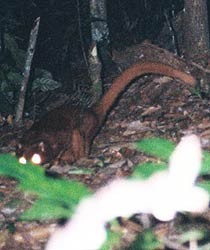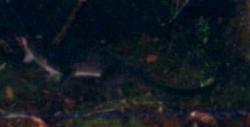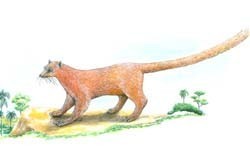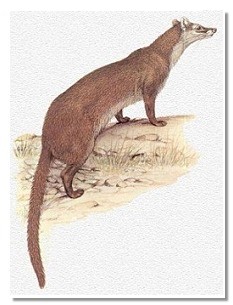
October 12, 2006
On December 5 and 7, 2005, Cryptomundo scooped the mainstream media with some analytical insights of the following Borneo photographs and the probable identification of the animal in the photographs. As this has surfaced again with regard to "new mammals" discoveries, and there are so many new Cryptomundo readers, here are those first postings on this mystery animal find.
What do you think this looks like? There is exciting news out of Borneo. A new red-furred animal larger than a domestic cat has reportedly been discovered on this remote island of Indonesia.

On December 5, 2005, the World Wide Fund for Nature (WWF) announced that they have discovered the "first new carnivore to be found in the region since the Tonkin otter-civet emerged in Vietnam in 1930." Also, the WWF said it would be the first new mammal to be specifically found on the island of Borneo since the Borneo ferret-badger in 1895.
The new carnivore was found in Kayan Mentarang National Park in Kalimantan, the Indonesian part of Borneo.
According to reports in The Times of London and other sources the "only evidence that exists are photographs taken by an automatically triggered camera on a jungle trail in Indonesia in 2003. Infuriatingly, a large leaf obscured the creature’s face as the shutter went off."
Stephen Wulffraat, discoverer of the so-far unnamed animal, noted: “We showed the photos to locals who know the wildlife of the area, but nobody had ever seen this creature before. We also consulted several Bornean wildlife experts. Some thought it looked like a lemur, but most were convinced it was a new species of carnivore.”
But doesn’t it seem obvious this looks more like a civet, than a primate?
The photographs show, writes reporters Nick Meo and Nigel Hawkes, "an enigmatic, red-furred creature with tiny ears and distinctive markings. The leaf that obscures its face makes it impossible to say if it has a pointed snout like a dog or fox, or a flat face like a cat. A second photo, from behind, shows it to have a long, bushy tail rather like a fox, and large hind legs. It is slightly larger than a domestic cat."
The mystery animal’s pictures were initially taken by WWF field researchers in 2003, but the photos were kept unpublished by the WWF as research continued. The WWF decided to make public the photos with the release of a book about Borneo.
The animal is slightly larger than a domestic cat with dark red fur and a long bushy tail. It was photographed twice by a night camera trap.
The photograph here is copyrighted by the WWF, and reproduced here for research purposes.
Possible Identification Proposed: The Rediscovery of an Extinct Species
The new animal from Borneo does somewhat match another camera trap "mystery creature" photographed by Malaysian wildlife specialists, and pictured directly below. This gave me a hint of what the "new" animal might be. Take a peek…


Photo credit goes to the Wildlife Conservation Society, Upper Baram Project, Malaysia. This organization obtained an interesting series of camera trap photos in 2004 on the unlogged areas of Mount Murud Kecil, Sarawak. One is of this slender unknown civet, shown above, with a very long tail, pale underparts and white around the muzzle, similar to Hose’s palm civet. This individual was photographed on the ridge of the mountain, far from the streams which are the Hose’s palm civet’s supposed habitat.

Compare the photos from Mount Murud Kecil, at the top of this blog, with this drawing of the newly discovered Borneo "civet." I think there is a good case to be made that the new Borneo animal is the allegedly extinct (since 1955) Hose’s palm civet, and may be similar to the above photographed "underreported" unknown civet from Mount Murud Kecil.
The new mammal "discovered" in Borneo, naturally, comes to the attention of cryptozoology and an analysis based on a broad review of what is ethnoknown about similar cryptids is helpful in revealing the "new" Borneo animal’s identity.
Please recall, this new Borneo animal is known only from two camera trap photographs (see our earlier blog), one of which shows this new animal with a leaf across its face and the other from behind. As far as is known, that is what has been deemed as evidence of this new animal’s "discovery."
But it does seem more proper to say this is the probable "rediscovery" of an extinct form, the Hose’s palm civet, as can be seen in a drawing from the excellent Lioncrusher reference site and shown directly below this paragraph. The Hose’s palm civet appears to be what we are talking about from Borneo, and in all of these situations.

Also, the "new" Borneo animal and the unknown Mount Murud Kecil civet reinforce, positively, the use of camera traps, as a method to show "hidden" animals, the foundation subjects of cryptozoology, literally the study of hidden animals.
With regard to this specific "new" Borneo animal, as noted above, it does therefore match this other camera trap "mystery creature" photographed by Malaysian wildlife specialists, which has never been widely shown before. The "new" Borneo animal is therefore a civet, members of the family Viverridae, and, I speculate, an example of a rediscovered (no longer extinct) Hose’s Palm Civet (Diplogale hosei).
BTW, the viverrids such as these Borneo civets, and the American procyonids (coatmundis and kinkajous) look like each other because of convergent evolution.
Thanks to Cameron and Matt Bille for data that reinforced our initial identification speculations in these "civet" blogs.
About Loren Coleman
Loren Coleman is one of the world’s leading cryptozoologists, some say “the” leading living cryptozoologist. Certainly, he is acknowledged as the current living American researcher and writer who has most popularized cryptozoology in the late 20th and early 21st centuries.
Starting his fieldwork and investigations in 1960, after traveling and trekking extensively in pursuit of cryptozoological mysteries, Coleman began writing to share his experiences in 1969. An honorary member of Ivan T. Sanderson’s Society for the Investigation of the Unexplained in the 1970s, Coleman has been bestowed with similar honorary memberships of the North Idaho College Cryptozoology Club in 1983, and in subsequent years, that of the British Columbia Scientific Cryptozoology Club, CryptoSafari International, and other international organizations. He was also a Life Member and Benefactor of the International Society of Cryptozoology (now-defunct).
Loren Coleman’s daily blog, as a member of the Cryptomundo Team, served as an ongoing avenue of communication for the ever-growing body of cryptozoo news from 2005 through 2013. He returned as an infrequent contributor beginning Halloween week of 2015.
Coleman is the founder in 2003, and current director of the International Cryptozoology Museum in Portland, Maine.
Filed under Breaking News, CryptoZoo News, Cryptozoology, Forensic Science, New Species